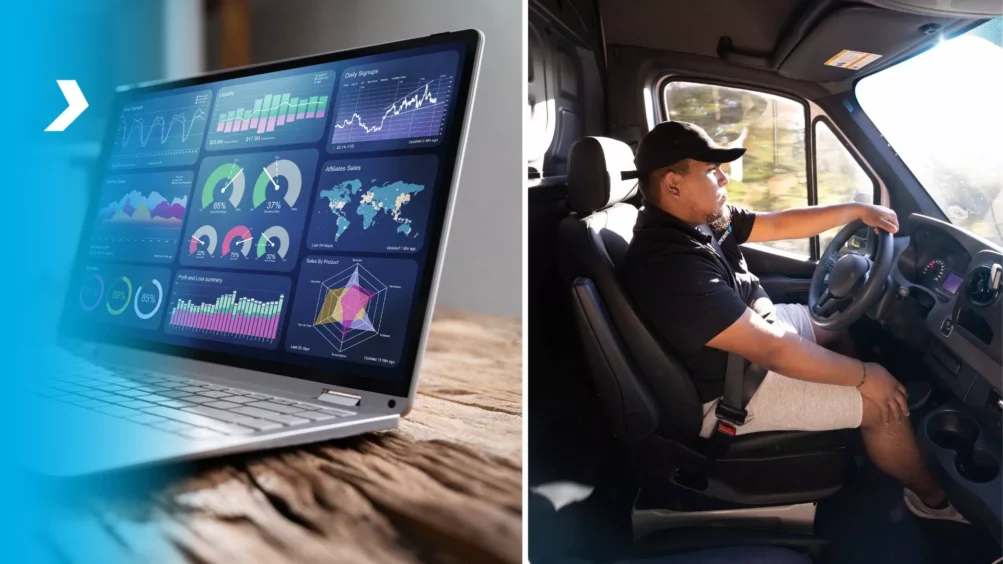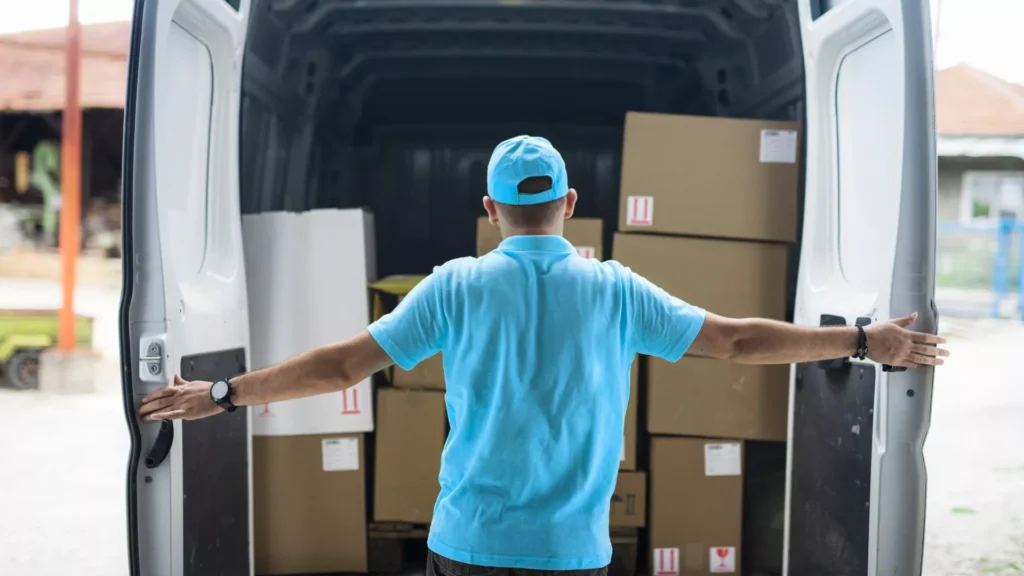
The Impact of Real-Time Data on Last-Mile Delivery
Although last-mile delivery is the shortest link in a supply chain, its importance is immense. This is because last-mile delivery is the only stage where a customer directly interacts with a carrier, shaping their overall experience. A poor last-mile delivery can severely damage customer satisfaction and harm the shipper’s reputation. To avoid this, carriers rely on real-time data technologies that provide vital information such as the shipment’s condition, location, estimated delivery time, etc.
Carriers using real-time data gain a significant advantage over those who don’t. They can optimize shipping routes dynamically, anticipate potential issues, and address them proactively. This strategy enables businesses to streamline logistics operations, avoid unexpected costs, and enhance both customer satisfaction and brand loyalty, keeping them one step ahead of the competition in the ever-evolving game of modern logistics.
Understanding Last-Mile Delivery and Real-Time Data
Last-mile delivery refers to the final leg of the shipping process, where a package is transported from a distribution center to the end customer’s location. This phase is accompanied by traditional challenges, like delays or mishaps, often leading to dissatisfaction and negative reviews.
Real-time data technologies are an effective tool in overcoming the traditional challenges of last-mile delivery. They involve collecting and analyzing information from various sources such as GPS, IoT sensors, and telematics, providing insights into the shipment’s location and condition. Further, this information enables carriers to adjust their operations on the fly to ensure timely deliveries.
Here is how real-time data can affect your logistics:
- Utilizing real-time data technologies gives the ability to optimize delivery routes. By analyzing traffic patterns and road conditions, carriers identify the most efficient paths, reducing transit times and fuel costs as well as minimizing the environmental impact of delivery operations.
- Real-time data also helps anticipate and mitigate potential issues. For instance, if a delay occurs due to traffic congestion or a mechanical problem, the system can automatically notify the customer with an updated delivery time. Such transparency helps manage customer expectations and reduces frustration.
- Real-time data enhances the overall visibility of the supply chain. Shippers and customers can track the exact location of their packages in real-time, providing peace of mind and reducing the uncertainty associated with delivery timelines. This is particularly important for high-value or time-sensitive shipments.
- Accurate and up-to-date information positively impacts inventory management. It allows businesses to manage their stock levels effectively, reducing the risk of overstocking or stockouts. This ensures that products are available when customers need them, further enhancing customer satisfaction.
Beyond a doubt, incorporating real-time data into last-mile delivery operations requires investment in advanced technologies and training. However, the benefits far outweigh the costs. It addresses many of the traditional challenges associated with this critical phase of the supply chain, enabling businesses to deliver a superior customer experience.
Benefits of Real-Time Data in Action
Real-time data technology has revolutionized routing in last-mile delivery. Powered by the ability to analyze live traffic conditions, weather forecasts, and road closures, carriers are now able to select the most efficient routes. This minimizes delays and reduces fuel consumption, leading to significant cost savings. Route optimization also enables carriers to handle more deliveries within the same time frame, increasing overall productivity.
Real-time data benefits:
Enhanced dispatch support
Dispatch operations are in the game. Thanks to modern real-time data tools, dispatchers can track the exact location of delivery vehicles and assign new tasks based on their current position and status. This dynamic ensures that resources are utilized efficiently, reducing idle time and improving overall operational efficiency.
Shorter delivery times
Real-time data technologies force the improvement in delivery times. With access to live information, carriers can make swift adjustments to avoid delays. For instance, if a traffic jam occurs, the system can reroute the driver instantly. This flexibility results in quicker deliveries and better customer satisfaction.
Enhanced communication
Real-time data also enhances customer communication. Customers can receive accurate updates about their delivery status, including estimated arrival times. This transparency reduces anxiety and improves the customer experience. With real-time tracking options and a sense of control, customers gain trust in the delivery process.
Cost reduction
Integrating real-time data into last-mile delivery improves routing and dispatching, which, in turn, leads to lower fuel and labor costs. Additionally, the ability to foresee and address potential issues before they escalate helps avoid costly disruptions. This efficiency translates into a more cost-effective operation, benefiting both the carrier and the customer.
Enhanced customer satisfaction
Positive customer feedback directly results from improved delivery times and transparent communication. When customers know exactly when to expect their deliveries, they are more likely to be satisfied with the service. This satisfaction leads to repeat business and positive reviews, which are invaluable for a company’s reputation.
Efficient use of resources
Real-time data supports better resource allocation. Companies can allocate their workforce and vehicles more effectively by analyzing delivery patterns and peak times. This means the right amount of resources is available when and where they are most needed, further optimizing the delivery process.
Near to zero downtime
Real-time data helps in managing unexpected situations. For example, if a delivery vehicle breaks down, the system can quickly identify the closest available vehicle to take over the delivery. This minimizes downtime and ensures that deliveries are still completed on time, maintaining service reliability.
Predictive inventory management
Accurate, up-to-date information on stock levels helps companies maintain optimal inventory levels. This reduces the risk of stockouts and overstocking and ensures that products are available for delivery when customers need them.
The transformative effects of real-time data on last-mile delivery extend from route optimization to enhanced customer communication, and the benefits are also substantial. Reduced costs, improved delivery times, and higher customer satisfaction are just a few of the advantages that make real-time data an indispensable tool in modern logistics.

Challenges and Future Prospects
Along with numerous benefits, adopting real-time data in last-mile delivery presents several challenges. One major issue is the technical infrastructure required. Implementing real-time tracking and data analysis systems involves significant investment in hardware and software. Companies need to equip their fleets with GPS devices, IoT sensors, and robust data management platforms, which can be costly.
Privacy concerns are another challenge. With real-time data, there is a constant flow of sensitive information, such as location and delivery specifics. Ensuring this data is protected from breaches and misuse is critical. Companies must comply with stringent data protection regulations, which adds to the complexity of deploying these systems.
Despite these challenges, the future of last-mile delivery looks promising with advancements in technologies like AI and IoT. AI can optimize various aspects of last-mile delivery, from route planning to demand forecasting.
Artificial intelligence
AI algorithms analyze tons of data to identify the most efficient delivery routes, taking into account real-time traffic conditions, weather, and other variables. By leveraging historical data and real-time information, AI can predict delivery windows more accurately, improving customer satisfaction. For instance, AI can foresee delays due to traffic or weather and adjust delivery times accordingly.
Internet of things
The Internet of Things (IoT) provides real-time data from connected devices. IoT sensors on delivery vehicles and packages can monitor conditions such as temperature and humidity, ensuring that sensitive goods are transported under optimal conditions. This data can help make real-time decisions to reroute deliveries or adjust handling procedures if issues arise.
Autonomous vehicles
Autonomous delivery vehicles and drones are another emerging trend in logistics. These technologies promise to reduce labor costs and increase delivery speed. Autonomous vehicles, guided by AI, can operate around the clock, making deliveries more efficient and reliable. However, regulatory hurdles and safety concerns need to be addressed before these technologies can be widely adopted.
Zero emissions delivery
Sustainability is a significant focus in last-mile delivery. Companies are exploring eco-friendly options like electric vehicles and reusable packaging to reduce their carbon footprint. They strive to address environmental concerns and meet the growing consumer demand for sustainable practices.
While adopting real-time data in last-mile delivery comes with challenges, advancements in AI, IoT, and autonomous technologies allow companies to expect more efficient, cost-effective, and customer-centric delivery solutions. The integration of these technologies will likely become a standard in the logistics industry, driving continuous improvement and innovation in last-mile delivery.
In Conclusion
Real-time data technologies have the power to significantly enhance last-mile delivery by improving route optimization and reducing delivery times. While their use is accompanied by traditional challenges, integrating AI and IoT technologies can help address them effectively and meet the growing demand for fast and reliable service. These technological advancements streamline logistics operations and offer cost savings and sustainability benefits. The future of last-mile delivery hinges on the continued adoption and evolution of these real-time data solutions, positioning companies to remain competitive in a rapidly changing market.
Consider how real-time data can transform your logistics operations. Share your thoughts and experiences in the comments below on integrating these technologies into your delivery processes.
You May Be Interested In
When the Unexpected Happens: Weekend Freight Support That’s Always On
The transportation industry doesn’t stop just because it’s the weekend. And neither does Expedite All. Emergencies, breakdowns, and time-sensitive recoveries don’t wait for business hours. That’s why our dedicated weekend freight support team is always on, ready to handle whatever the road throws your way. When the unexpected happens, Expedite All is your partner in […]
Expedite All Launches Lower-Cost, More Sustainable Expedite Shipping Network
Expedite All today announced the launch of a new, nationwide expedite transportation network that gives shippers on-demand access to more than 1,000 carriers offering over 5,000 expedite vehicles at rates up to 10% lower than traditional expedite.